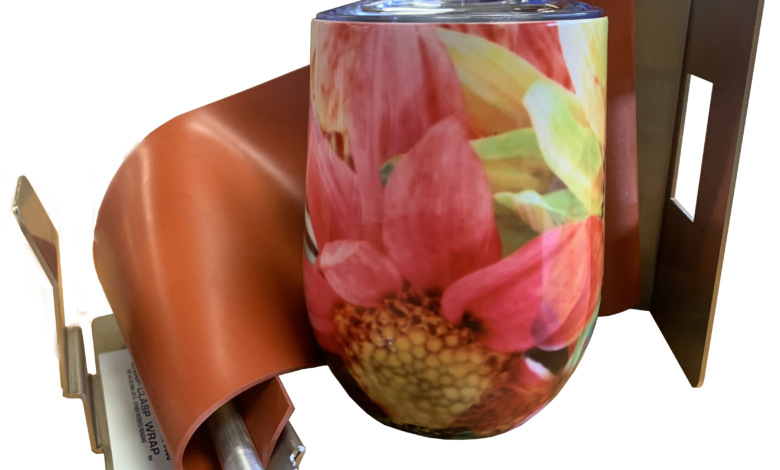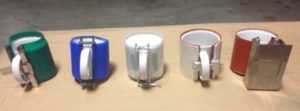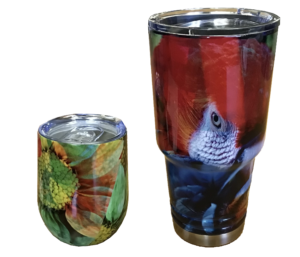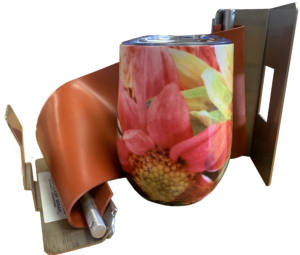
Mug wraps are simple pressure devices consisting of a clasping mechanism and a silicone pad that wrap and lock around a substrate providing a close fit between transfer and substrate. There are a variety of wraps in the market, which can be divided up in the following ways:

- Tool-less vs. tool-required wraps
- Welded wraps vs. wraps with removable silicone
- Straight-walled vs. tapered-walled wraps
- Wraps for small, medium, and large substrates
- Custom wraps and irregularly shaped substrates
- Manual wraps vs. automatic wrapping devices
Wraps work in conjunction with a sublimation oven whereby wraps provide the pressure and the oven is the heat needed to sublimate.
Tool-less vs. tool-required wraps
Some wraps need drills with special drill bits to open and close the wrap at each cycle. Firm and repeatable pressure is possible with these devices. However, the additional manipulations cost time and effort and delay the process. In addition, overtightening can easily snap off the mug’s handle.
Some mug wraps may require no tools but are clumsy to open and close, costing time. The best choice is a wrap that opens and closes quickly and easily without additional tools.
The HIX 2-step wrap is an example of a manual, tool-less wrap. The clasp mechanism stretches the entire surface of the silicone resulting in even pressure over the whole surface and the capability of top-to-bottom sublimation coverage.
The double-locking system closes the gap almost entirely, allowing full 360-degree sublimation of substrates without handles.
Welded wraps vs. wraps with removable silicone
 Welded wraps are permanently attached (welded) to the steel holding pins or the wrap assembly. This effectively turns the entire wrap into a disposable tool.
Welded wraps are permanently attached (welded) to the steel holding pins or the wrap assembly. This effectively turns the entire wrap into a disposable tool.
Since good quality silicone has an average lifespan of about 100-150 cycles, the welded wrap, although cheaper to acquire, may end up being a more expensive investment because of its disposable nature.
Wrap mechanisms like the one to the right can be detached from the silicone with four screws. The clasp assembly itself sustains very little wear-and-tear and has a near indefinite life expectancy. Since silicone is often the least expensive component to replace, the replacement-silicone option may offset a higher initial investment.
Straight-walled vs. tapered-walled wraps
Straight-walled wraps cover mugs with parallel walls. Tapered-walled wraps cover substrates with slanted walls. Both straight- and tapered-walled wraps can have different heights, depending on the size of the substrate. Ideally, the wrap needs to provide about ¼” of overhang on the edges of the mug to provide a good, firm fit for the transfer.
Wraps for small, medium, and large substrates
Although most drinkware in the market is the standard 11/15-oz. mug, a growing variety of substrates appear in the marketplace regularly, requiring different sizes of wraps to sublimate.

Sizes may vary from the tiny shot glass to the tall travel cooler and narrow pint glasses to wide dog or cat bowls. Each shape and size requires a different mug wrap. There will be uneven pressure on the mug’s surface if there’s a difference between the slanting angle of the wrap and the substrate. The wraps’ height needs to be sufficient to cover and, even better, overlap the printing surface.
Some unusual, non-standard shaped or sized substrates require a custom-manufactured wrap.
Custom wraps and irregularly shaped substrates

Irregular surfaces are harder to sublimate on but not impossible. Some of the often-heard challenges are top-to-bottom sublimation. This requires a firm silicone durometer, providing pressure over the entire surface. In addition, the wrapping mechanism needs to be constructed so that the silicone remains firmly in place while stretched and heated up to 400 F.
Achieving 360-degree circumference sublimation requires similar silicone characteristics. In addition, the wrap needs to be constructed so that, when fully locked, it provides pressure over the entire surface of the substrate. Few wraps can provide this.

Wrapping irregular surfaces such as tumblers, coolers, metal wine cups, etc., require good wrapping mechanisms — almost always a custom-designed wrap and a little creative imagination.
The large tumbler pictured above was wrapped with two different wraps — one for the top and one for the bottom section, including sufficient silicone overhang at both ends. Both wraps had double-locking systems allowing near-360-degree coverage.
The wine cup below was done with one wrap and sufficient overhang, plus some tight taping at the curvature.
Manual wraps vs. automatic wrapping devices
A question we often hear is, “Does an automatic wrapping system exist to speed up my production?” They do, but they are usually custom-made and expensive. Manual wrapping devices work well but can have limitations in the size and shape of the substrate they can handle.
Variation in silicone quality and durometer
The quality and durometer of the silicone directly relate to the flexibility and longevity of the wrap. Keeping the wraps in a dry, cool place, allowing them to cool between cycles and not loosely throwing them in boxes but instead hanging or laying them to cool, promotes longevity.
The durometer of the silicone is important as well. Too soft, and the wrap provides insufficient tension, translating into reduced pressure onto the mug walls. This creates fuzzy images or loss of detail. Too hard, and the clasp is too difficult to lock and open.
A “Goldilocks solution” provides the best trade-off between tension/pressure on the one hand and user-friendliness/ease of manipulation on the other.
Can everything be wrapped?
A round surface is necessary, whether straight-walled or slanted, to provide pressure to every square inch of a substrate and allow crisp and detailed outcomes of a design onto a substrate. Flat or curved surfaces require a different technique, as surface pressure is lost when silicone is stretched over a flat or slightly curved substrate. Heat presses with a curved platen work well for these applications, like a cap press or flat press. Another option is a heat press with a specialty lower platen.
Now that you have a full breakdown of sublimation mug wraps, you’re ready to choose the right one for the job.
Happy sublimating!








